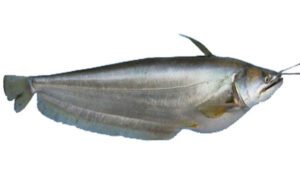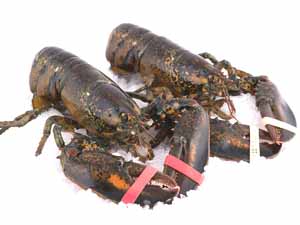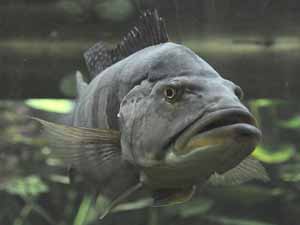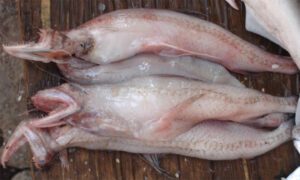The Alaska Pollock fish is a marine fish species of the cod family Gadidae. It is also called Walleye Pollock and is widely distributed in the North Pacific with largest concentrations found in the eastern Bering Sea.
While belonging to the same family as the Atlantic pollock, the Alaska pollock is not a member of the same Pollachius genus. The species was long put in it’s own genus ‘Theragra‘, and classified Theragra chalcogramma.
But more recent research has shown that it is rather closely related to the Atlantic cod and should be moved back to genus ‘Gadus’ in which is was originally described. Likely the same species as the Alaska Pollock fish is the Norwegian Pollock which is a rare fish of Norwegian waters.
Currently, the Alaska Pollock fish is widely distributed in the temperate to boreal North Pacific, from Central California into the eastern Bering Sea, along the Aleutian arc, around Kamchatka, in the Okhotsk Sea and into the southern Sea of Japan. However, read some more information about this fish species below.
Alaska Pollock Fish Characteristics
Body color of the Alaska Pollock fish is olive green to brown on the back, and becomes silvery on the sides and pale ventrally, often with mottled patterns or blotches.
Their dorsal fins are widely separated, and the pelvic fins have a slightly elongated filament. The lateral line is continuous to about the back end of the first dorsal-fin base.

Average body length of the Alaska Pollock fish is around 80 cm, with a maximum recorded length of 91 cm. And their maximum recorded live body weight is 3.9 kg. Photo and info from Wikipedia.
Diet
The Alaska Pollock fish are mainly feed on krill, but they also eat fishes and crustaceans.
Breeding
Spawning of the Alaska Pollock fish generally occurs mostly from January to March in the Strait of Georgia and the Aleutian Basin.
But it occurs much later (extending to August) to the northwest of the Privilof Islands, than in the southeastern Bering Sea. Amount of eggs vary depending on the age of the females.
A 4 years old female generally lay around 520,000 eggs per spawning, and a 15 years old female can lay up to 15 million eggs per spawning.
Uses
Currently this fish has become an important food fish for humans. But it was used only for animal feeds in the past.
Currently it is marketed in the form of frozen blocks, roe and salted products.
Special Notes
The Alaska Pollock fish are long lived fish. Their maximum recorded lifespan is 28 years. It is the world’s second most important fish species in terms of total catch.
It has been said to be ‘the largest remaining source of palatable fish in the world’. And around 3 million tons of Alaska Pollock fish are caught each year in the North Pacific from Alaska to northern Japan.
Currently the Alaska Pollock fish is mainly used for food for human consumption. But it was previously used only for animal feeds. It is commonly used in the fast food industry.
This fish has a milder taste, whiter color and lower oil content. It is a very fast growing fish species. However, review full breed profile of this fish in the table below.
| Name | Alaska Pollock |
| Kingdom | Animalia |
| Phylum | Chordata |
| Class | Actinopterygii |
| Order | Gadiformes |
| Family | Gadidae |
| Genus | Gadus |
| Species | G. chalcogrammus |
| Binomial Name | Gadus chalcogrammus |
| Other Names | Walleye Pollock, and also known by some other names in different parts of the world |
| Breed Purpose | Mainly food |
| Special Notes | Economically very important fish species throughout the world, very fast-growing fish species, today mainly used for food, previously used for animal feeds, commonly used in the fast food industry, fast growing species, long lived fish, average 28 years of lifespan, world’s second most important fish species in terms of total catch |
| Weight | Around 3.9 kg |
| Breeding Method | Natural |
| Climate Tolerance | Almost all climates |
| Body Color | Olive green to brown on the back, and becomes silvery on the sides and pale ventrally, often with mottled patterns or blotches |
| Rarity | Common |
| Availability | Worldwide |






